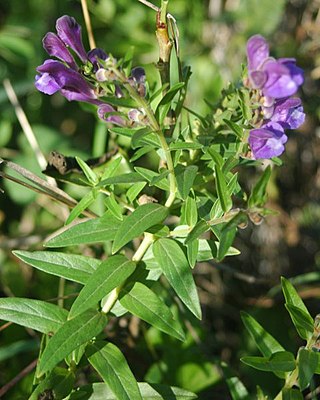
Scutellaria montana, with the common names largeflower skullcap, large-flowered skullcap and mountain skullcap, is a perennial forb first described by Alvan Chapman in 1878. This narrowly endemic species is found in the southeastern United States in parts of the Ridge and Valley and Cumberland Plateau Physiographic Provinces. Populations have been documented from four Tennessee counties and nine Georgia counties and is protected under the US Endangered Species act as it is a threatened species. The Latin specific epithet montana refers to mountains or coming from mountains.

Allium drummondii, also known as Drummond's onion, wild garlic and prairie onion, is a North American species of onion native to the southern Great Plains of North America. It is found in South Dakota, Kansas, Nebraska, Colorado, Oklahoma, Arkansas, Texas, New Mexico, and northeastern Mexico.
Skullcap or skull cap usually refers to various types of headgear. Specifically it may refer to:

Scutellaria barbata, the barbed skullcap, is a species of flowering plant in the mint family, Lamiaceae. It is native to Asia.

Scutellaria is a genus of flowering plants in the mint family, Lamiaceae. They are known commonly as skullcaps. The generic name is derived from the Latin scutella, meaning "a small dish, tray or platter", or "little dish", referring to the shape of the calyx. The common name alludes to the resemblance of the same structure to "miniature medieval helmets". The genus has a subcosmopolitan distribution, with species occurring nearly worldwide, mainly in temperate regions.

Scutellaria baicalensis, with the common name Baikal skullcap or Chinese skullcap, is a species of flowering plant in the family Lamiaceae.

Banksia drummondii, commonly known as Drummond's dryandra, is a species of shrub that is endemic to Western Australia. It has pinnatifid to pinnatisect leaves, heads of up to one hundred cream-coloured, red and yellow flowers and glabrous fruit.

Scutellaria lateriflora, is a hardy perennial herb of the mint family, Lamiaceae, native to North America.

Scutellaria galericulata, the common skullcap, marsh skullcap or hooded skullcap, is a hardy perennial herb native to northern areas of the Northern Hemisphere, including Europe, Asia, and almost all of Canada. It is a member of the mint family. The form is upright and is usually 20-45 centimeters in height, sometimes reaching up to 80 cm. It is a wetland-loving species and grows along fens and shorelines. The blue flowers are 1 to 2 centimeters long. The flowers are in pairs and are all on the same side of the stem. The flowers do not appear at the top of the stem.

Scutellaria ovata, commonly known as the heartleaf skullcap, is a member of the mint family (Lamiaceae). Its range in the United States is from Minnesota to Florida, and from Texas to the Atlantic coast. It is also native to Mexico.

As baicalin is a flavone glycoside, it is a flavonoid. It is the glucuronide of baicalein.

Baicalein (5,6,7-trihydroxyflavone) is a flavone, a type of flavonoid, originally isolated from the roots of Scutellaria baicalensis and Scutellaria lateriflora. It is also a constituent of Oroxylum indicum and thyme. It is the aglycone of baicalin.

Scutellarein is a flavone that can be found in Scutellaria lateriflora and other members of the genus Scutellaria, as well as the fern Asplenium belangeri.

Wogonin is an O-methylated flavone, a flavonoid-like chemical compound which is found in Scutellaria baicalensis.

Oroxylin A is an O-methylated flavone, a chemical compound that can be found in the medicinal plants Scutellaria baicalensis and Scutellaria lateriflora, and the Oroxylum indicum tree. It has demonstrated activity as a dopamine reuptake inhibitor, and is also a negative allosteric modulator of the benzodiazepine site of the GABAA receptor. Oroxylin A has been found to improve memory consolidation in mice by elevating brain-derived neurotrophic factor (BDNF) levels in the hippocampus.

Scutellaria minor, the lesser skullcap, is a species of flowering plant in the family Lamiaceae.
Cehei Pond Nature Reserve is situated in north-western Romania, in Crasna river floodplain, in Sălaj County and is a protected area with aquatic vegetation and fauna specific to such area.

Scutellaria parvula, commonly known as the small skullcap, is a member of the mint family. It is native to eastern and central North America, being most common in the central states and become rare in the east. It is found in areas that provide ample sunlight, such as prairies, glades, and savannas, often in calcareous soil. Flowering time is from late spring to early summer.

Symphyotrichum drummondii is a species of flowering plant of the family Asteraceae native to the central and eastern United States. The common name Drummond's aster has been used for the species. There also is an accepted variety native to the south-central United States and northeast Mexico named S. drummondiivar. texanum. This variety has the common name of Texas aster. The species is a perennial, herbaceous plant that may reach 120 centimeters in height.

















